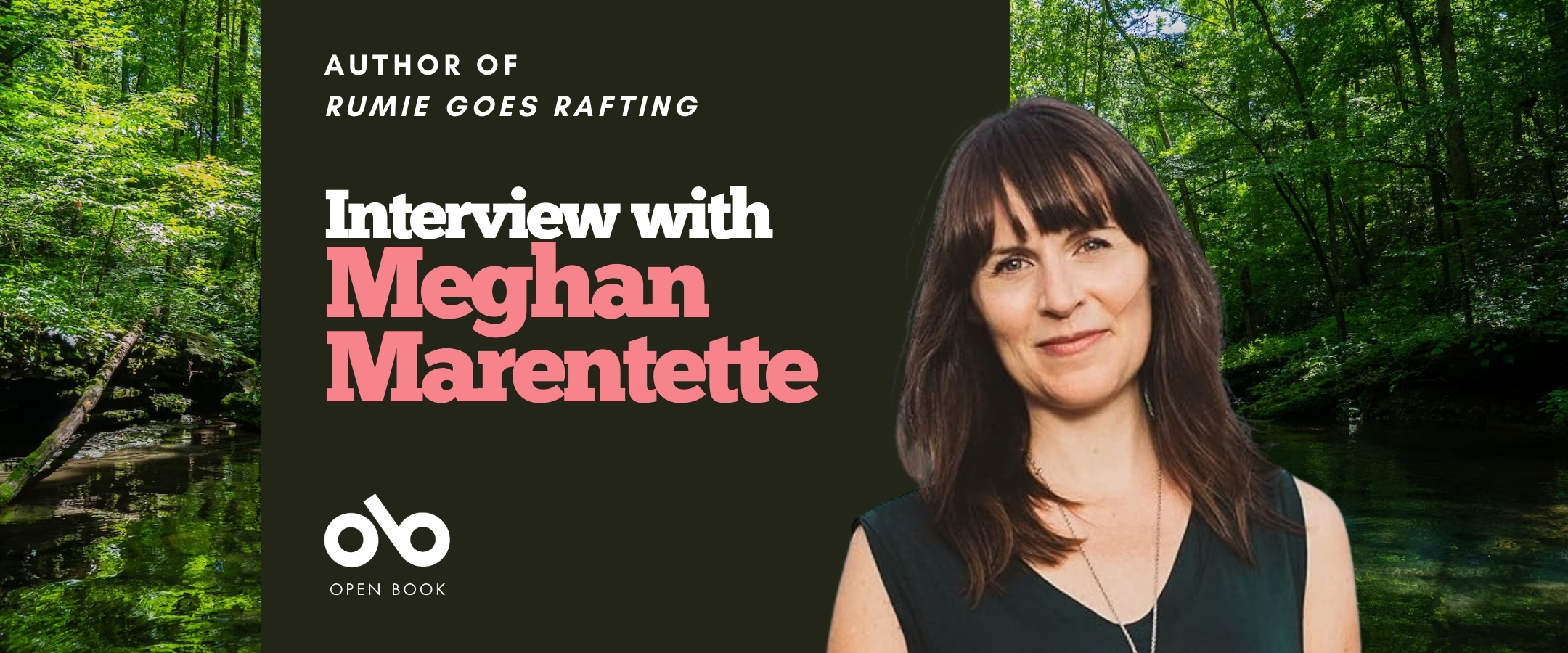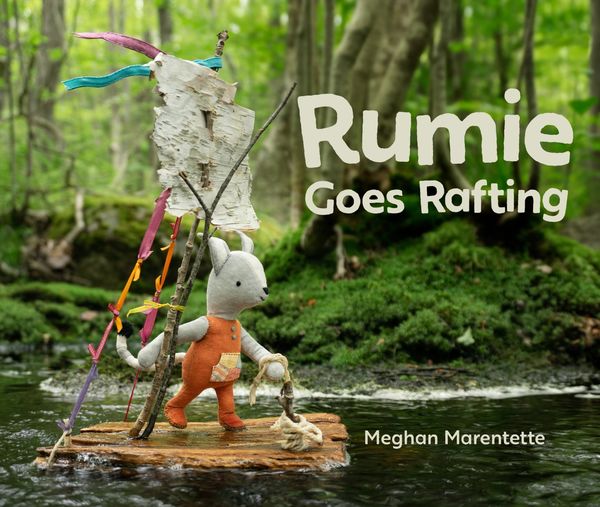Rumie Goes Rafting is a Stunning Debut Where Plush Animals and Real Woodlands Tell the Tale
Lovers of adventure (and puppets!) will delight in reading the latest book by Meghan Marentette. The talented author and artist has worked in a number of mediums, including television, and pairs that experience in bringing characters to life visually with her passion for nature.
In Rumie Goes Rafting (Owlkids Books), we follow the titular character as she longs to sail down a stream near her forest home, but can't navigate the shallow waters in her Uncle Hawthorne's boat. Inspiration comes as a ladybird floats past on a leaf, and Rumie realizes she can build a raft for the journey. When she wakes up, she tries to test the raft along, but. a strong current upends this task and sets Rumie on her way.
Told with verve and joy, all with the backdrop of cuddly plush critter against a real forest backdrop, Rumie Goes Rafting is a visually spectacular debut. We're very excited to share this Kid's Club Books for Young People Interview with the author today!
Open Book:
Tell us about your new book and how it came to be.
Meghan Marentette:
Rumie Goes Rafting was a long time coming! It took me 5 years to create, and 40 before that to hatch. I had always dreamed of being a picture book artist, but didn’t really take to painting. The joys of my childhood were making miniature worlds for my toys, reading picture books (into my teens), watching and listening to every version of The Wind in the Willows I could find, and looking through my mother’s View-Master from 1953. How I adored looking through a window into another world! With no real understanding of how those passions could translate into a career, I ended up working in the film industry as a costume maker, forgetting my own art. In my 30s, I began to burn out. I needed a break, and felt ready to create a world of my own. I just couldn’t put my finger on exactly how I’d do it.
I started by writing a children’s novel, about an adventurous mouse called The Stowaways. I loved writing it, and was so proud that I had finally taken the leap to create my own tiny world―but what I really wanted to do was crawl right inside it. I needed to become a visual artist. Specifically, of dioramas.
On my many walks in the forest, wondering if I’d ever find it within myself to take the leap into visual storytelling, I discovered an idyllic stream. I was mesmerized by its beauty, and found myself crouching down to look at it from a tiny point of view. I soon brought my camera and a little toy mouse with me, and began to experiment with creating photo-illustrated storylines of the tiny creature interacting with nature. After many months of practicing miniature photography by this stream, a character came to mind that I wanted to meet ‘in person’. Having acquired the skills to make stop motion puppets during my film career, I created Rumie as a wire-framed plush puppet. When I stitched the last of that little smile on, I knew: this was what I had wanted to create as a child.
It’s not surprising that Rumie Goes Rafting is a metaphor for my own journey―just as I was inspired to go after a long-awaited vision when I happened upon this stream, Rumie is inspired to build a raft and jump aboard it, after a long-awaited rain. We both get swept away by the excitement of creative adventure, but it all comes out fine in the end.
OB:
Is there a message you hope kids might take away from reading your book?
Your CanLit News
Subscribe to Open Book’s newsletter to get local book events, literary content, writing tips, and more in your inbox
MM:
I avoid heavy messaging in my writing, because I believe children learn best through gently supported free play; essentially, they learn most meaningfully by doing. In my experience, when children are allowed to follow their own inspiration, they not only learn what they are capable of, but they can also gain the confidence to be inwardly resourceful when met with parameters, risk and failure. Rumie is the essence of a child allowed to play freely, and Uncle Hawthorne is the essence of a guardian who aims to listen, ask questions and guide―though he doesn’t always succeed!
Through the gentle joy and love the characters express for each other and their woodland home, I hope young readers will relax into Rumie’s world, look carefully at the details, and feel inspired to create their own worlds and adventures with the objects and locations in their environment.
For readers of any age, I hope this book provides an escape into an idyllic world of peace and creativity, where we’re accepted for who we are, supported by nature and family.
OB:
What was the strangest or most memorable moment or experience during the writing process for you?
MM:
I love writing the words of a story, but to actually create its scenes in 3-D is fantastic, in the literal sense of the word. When I’m in the process of illustrating a Rumie scene, it’s always a thrill to look through the camera lens onto an actual scene where my characters appear to be real, but there was a moment while I was photographing the scene at the dock, where Uncle is tying on Rumie’s life vest, when I was pulled so far into the fantasy that I actually cried with joy. On my last day shooting that scene (each one takes several days to find the right placement, angle and weather), a green frog poked its head out of the water in a perfect spot in my frame. It stayed absolutely still, intently watching Uncle and Rumie, for 15 minutes. I was blown away—did the frog really think my puppet characters were alive and part of his world? I felt like I had crossed an invisible line where my fantasy world had become real! I’ll never forget that moment. (The frog made it onto the page; you can find it near the tip of Uncle Hawthorne’s tail).
OB:
What do you need in order to write – in terms of space, food, rituals, writing instruments?
MM:
The main challenge in writing and creating photo-illustrated books is the amount of space it takes. I have sets, materials, tools, cameras, computers and lighting gear covering every surface and stuffed in every closet. My dream would be to have a huge studio with all my sets permanently installed like a museum display, with rows of tidy shelving and transparent drawers, so I could walk in and have access to everything, all the time! But being a creator requires creativity in every part of life―you have to deal with the parameters. If the passion to do it is still there despite chaotic circumstances, then this is what you should be doing! So as much as I have a long list of wishes in my head, none of them really matter.
OB:
How do you cope with setbacks or tough points during the writing process? Do you have any strategies that are your go-to responses to difficult points in the process?
MM:
I’ve never had much creative doubt, maybe because I worked for so many years in the film industry with constant deadlines and design issues to solve―I had to learn to trust myself in order to handle the demands. Solutions always present themselves when they are needed; sometimes, the less time you have, the easier it is to find one! But Rumie books are a slow burn. The detail required is painstaking, because I aim to make every prop match Rumie’s concept―as a step away from the human world, I take care to imagine how Uncle Hawthorne would design a chair, what materials he could use from the forest, what Rumie might find on a scavenger hunt, and how that might be used to make something in their home. Each scene takes a long time to complete; sometimes months to gather the materials and make all the props for just one photo. But that’s the joy of it for me―I get to enjoy the process!
The challenge is that one Rumie book takes years to complete, and it can be tough to keep the energy level up on such a giant project when I work all alone. There’s no teammate at the next table I can stop and have a chat with; it’s just me, my puppets and I. One day I would love to build an artist commune with a circle of separate art studios placed around a central room where we can convene for tea and giggles. Until then, I am always looking for connections with other creators to enjoy when I can.
OB:
What are you working on now?
MM:
I’m now working on a second Rumie book, set in winter. Where the challenge in creating Rumie Goes Rafting was in finding the right level of water for the images taken on the stream, I now face winters that are getting warmer and shorter and there is less fresh snow to serve as background for the exterior shots of the story. I avoid using photoshop and fake snow because if I used shortcuts, I wouldn’t be able to feel what Rumie feels; I’d lose both the joy and the experience of being in nature, and feeling inspired by what is. I’d lose the ability to capture that on camera. What I love about the challenge of shooting in nature is that I have to really be there in order to find the image I’m looking for―somewhere in the shapes and colour of the background, with the right light and weather, I have to find the right combination that tells the story. It brings me right back to that natural creative state I had as a young child. That sense of curious wonder is what I most want to express in Rumie’s world.
_______________________________________
Meghan Marentette lives near a wild wood in Nova Scotia, where she spends her time writing, crafting, and lying on the forest floor, imagining the world from a tiny point of view. This is her debut picture book.






